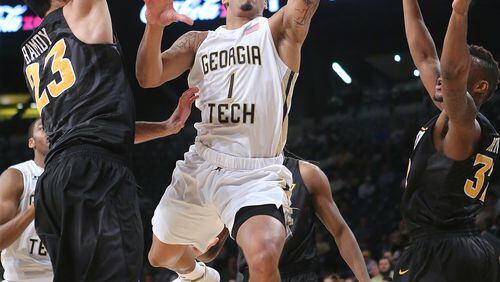Georgia Tech plays Colgate for the first time in school history Wednesday at McCamish Pavilion at 7 p.m. The game will be broadcast on 680-AM and online through ESPN 3.
40 minutes of focus
Against a second consecutive opponent that the Yellow Jackets ought to defeat, Tech needs to play with better focus than it demonstrated against Southeastern Louisiana. Against the Lions on Monday, Tech pushed out to a 24-point lead in the first four minutes of the second half, but ended up winning by 13, 75-62. SLU shot 59.3 percent against Tech in the second half, which is better than any Jackets opponent had shot for a half this season. Not the sort of thing you want to permit against a team with an RPI over 300.
“We contained (SLU’s guards) pretty well for the first 30 minutes, but the last 10, we didn’t do a good enough job on them,” coach Brian Gregory said. “Just not able to maintain that level of intensity and, at times, concentration on some of that stuff. It’s an area we need to improve on.”
Presumably, maintaining focus will be easier against North Carolina in the ACC opener Jan. 2 than it was against Southeastern Louisiana. That said, Tech had problems last season allowing teams to rally, a factor in their 3-15 ACC record.
“You can’t play in stretches with who we’re going to play against,” Gregory said. “You can’t do that.”
About Colgate
Colgate (4-6) plays out of the Patriot League, which last year was No. 18 in conference RPI out of 33 Division I leagues. The Raiders finished second in the league last season but lost four starters. In their two games against power-conference teams this season, they lost 76-49 to TCU and 78-51 to Syracuse.
Colgate starts one senior, three sophomores and a freshman. Only one, guard Austin Tillotson, averages in double figures, at 11.5 points per game.
The Raiders have one player from metro Atlanta, junior guard Nathan Harries, a Centennial High grad who has played in one game this season. Harries received a small degree of fame in 2013 when the NCAA denied him a year of eligibility because he played in three games in a church league in Dunwoody. NCAA rules stipulate that any athlete who does not enroll in college immediately after graduating from high school (Harries served a two-year Mormon mission) will lose a year of eligibility for each year they compete in organized competition. The NCAA ultimately reversed its decision.
Colgate is coached by Matt Langel, who was a star at Penn in the late 90s and has improved the Raiders’ win total in each of his first four seasons. I think I wrote about his younger brother Casey when I covered high school basketball in New Jersey for the Philadelphia Inquirer.
The school was named in honor of William Colgate, a benefactor and also the founder of the Colgate toothpaste brand. Tuition is $49,970. Good thing they were able to keep it under $50,000. That would be too expensive.
RPI report
After defeating Southeastern Louisiana, which went into the game ranked No. 337 in RPI, Tech’s RPI dropped from No. 82 to No. 114. Colgate was No. 209 as of Wednesday morning. Duquesne, which is Tech’s final non-conference opponent, was No. 122.
More time for White?
After the game Monday, Gregory was non-committal about giving another start to forward James White. In his first start of the season, White had 12 points and a season-high 13 rebounds in a season-high 22 minutes. In his past three games, White has 29 rebounds in 53 minutes.
His rebound-per-minute rate is actually quite comparable to forward Charles Mitchell, who through Monday's games was fifth in the country at 12.2 rebounds per game. Mitchell is averaging .456 rebounds per minute while White is at .413. If White had played the same number of minutes as Mitchell thus far and maintained the same rate, he would be averaging 11 rebounds per game, which would be tied for 11th in the country.
“Obviously, he’s a different rebounder than Chuck and Nick (Jacobs),” Gregory said. “Ben (Lammers) kind of rebounds with length. Chuck and Nick kind of rebound with brute force, and then James is kind of the long, athletic rebounder in spaces and is able to play over the top of guys.”
Shooting better
It’s a small sample size, but forward Quinton Stephens has made 41.4 percent of his 3-point tries this season, a significant jump from his rate last season, 29.9 percent. Forward Marcus Georges-Hunt has likewise improved, up to 38.2 percent from 28.8 percent last season. (His high for a season was 34.1 percent as a sophomore.)
Stephens was 0-for-4 from behind the arc and 0-for-7 overall. Gregory said that “we need him to make those shots. He’s not a guy that presses, but I thought all those shots were open looks. They were all open looks. So you’ve just got to get in the gym and keep shooting and feel confident that you’re going to put those in.”
Gregory had another issue with the 3-point shooting, particularly in the first half when half of the Jackets’ 34 field-goal tries were 3-point tries. He felt that a lot of the shots were taken early in possessions and were shots that would still have been available three or four passes later.
“If we get the ball, either on a post touch, post flash or dribble penetration and then you take those shots, you have the zone broken down and, if the zone is broken down, then if you miss, we have a better chance of getting an offensive rebound,” he said.







